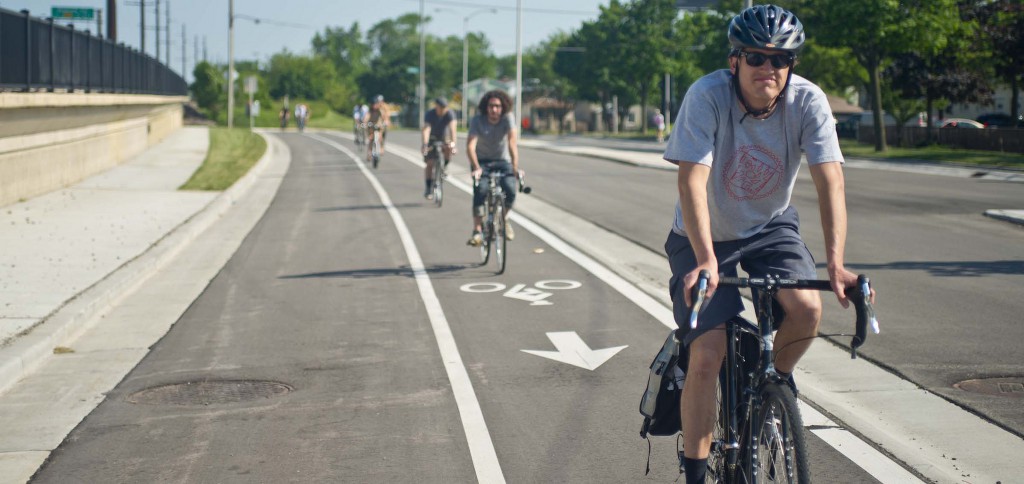Study indicates public investment pays off in pedestrian, bicyclist safety
The findings suggest an important connection between walk-friendly and bicycle-friendly communities and safety.

Milwaukee’s raised bike lane on Bay Street is the first modern protected bike lane constructed in Wisconsin.
MILWAUKEE _ A new study of pedestrian and bicycle travel suggests investment in infrastructure and policies to encourage walking and biking is correlated with lower rates of pedestrian and bicyclist deaths.
The work by researchers at the University of Wisconsin-Milwaukee and the University of Wisconsin-Madison also identifies the safest and most dangerous metropolitan regions for pedestrians and bicyclists in the U.S.
Using improved travel data, Robert Schneider and Aida Sanatizadeh of UW-Milwaukee’s School of Architecture and Urban Planning and Jason Vargo of the UW-Madison Global Health Institute calculated the rates of fatalities for walkers and bicyclists in 46 American regions with populations greater than one million.
The fatality rates varied dramatically.
“First, we did an informal comparison of fatality rates and were surprised to find how different the regions were from top to bottom,” said Schneider. “The five most dangerous regions for walking had an average fatality rate five times higher than the five safest regions. For bicycling, the most dangerous regions had a fatality rate six times higher.”
But Schneider notes that the data for certain regions was less reliable than others because of limited survey data.
“So we used a more rigorous method called meta-analysis to identify regions that stood out as much higher-than-average and much lower-than-average.”
The safest regions identified by the meta-analysis were:
Walking
|
Bicycling
|
The most dangerous regions were:
Walking
|
Bicycling
|
“We compared our lists of the safest and most dangerous regions with the ‘Walk Friendly Community’ and ‘Bicycle Friendly Community’ rankings, which are based on the investments cities make in infrastructure and programs,” Schneider said. “The general connection between high rankings and low fatality rates is a good indication that those investments have paid off.”
Schneider also raises another possibility: “Communities that were developed in a more pedestrian- or bicycle-friendly pattern to begin with – typically older urban areas – may have chosen to continue to invest in walking and bicycling, meaning that the relationship may work in both directions.”
In either case, the findings suggest an important connection between walk-friendly and bicycle-friendly communities and safety, he said.
Schneider noted that the findings for bicycle safety, while generally in line with the pedestrian rates, were not as robust because of smaller sample sizes.
The study uses data from the National Household Travel Survey, which includes work, recreational, shopping, school and social trips, so it goes beyond the “journey-to-work” data collected by the U.S. Census.
“Including non-work trips allows you to calculate a more accurate estimate of fatalities per trip, per minute, or per mile,” Schneider said.
Analysis of all 46 regions also provided support for the “safety in numbers” hypothesis: More pedestrian and bicyclist traffic overall is related to lower crash risk for each person walking and bicycling.
When the researchers examined socio-demographic characteristics, they found evidence that higher senior-age populations, higher poverty rates and higher rates of people born outside of the U.S. were correlated with higher pedestrian fatality rates. The study did not examine causal connections between these characteristics and safety, but the authors suggest policy measures that might address them.
“[S]afety initiatives should be honed to reduce pedestrian and bicyclist fatality risk in immigrant communities and to make pedestrian travel safer for the growing senior-age population,” the authors write.
Recognized as one of the nation’s 115 top research universities, UW-Milwaukee provides a world-class education to 26,000 students from 89 countries on a budget of $667 million. Its 14 schools and colleges include Wisconsin’s only schools of architecture, freshwater sciences and public health, and it is a leading educator of nurses and teachers. UW-Milwaukee partners with leading companies to conduct joint research, offer student internships and serve as an economic engine for southeastern Wisconsin. The Princeton Review named UW-Milwaukee a 2017 “Best Midwestern” university based on overall academic excellence and student reviews, as well as a top “Green College.”
NOTE: This press release was submitted to Urban Milwaukee and was not written by an Urban Milwaukee writer. While it is believed to be reliable, Urban Milwaukee does not guarantee its accuracy or completeness.























